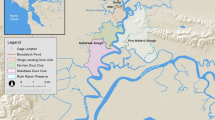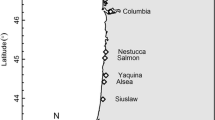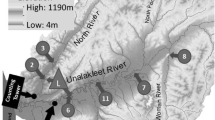Abstract
This study explores the stocking efficiency of Atlantic salmon juveniles in a 4th order stream located at the southern limit of its Eastern Atlantic distribution. Moreover, with the idea of implementing new protocols and methods to improve “traditional” hatchery practices and rear a more “wild” like fish, the study examines the response of this species to natural diet preconditioning prior to release. The field study indicated that most juveniles disappeared from the stocked reaches within two months of their release, resulting in a recapture rate after a year of 0.0–1.1 %. There were no differences in stocked juvenile’s density along the stream during the first months following stocking. The preconditioning experiments showed that juveniles of Atlantic salmon suffered a significant decrease in their condition factor when diet was changed from artificial pellets to live preys, either if the change occurred before (i.e., in a manipulative experiment) or after their release in the stream. Although weight, length, condition factor and specific growth rates reached by juveniles at the end of the rearing period were higher in individuals fed on pellets than in those fed on macroinvertebrates, differences disappeared only a week after their release in the stream. These results may have implications regarding the stocking success when releasing hatchery-reared Atlantic salmons in suboptimal environments. In particular, the study indicates that stocked salmon adaptation in the selected stream may not be improved by short conditioning periods to natural diet prior to their release, while we discuss potential explanations for the observed results.




Similar content being viewed by others
References
Álvarez D, Nicieza AG (2003) Predator avoidance behaviour in wild and hatchery-reared brown trout: the role of experience and domestication. J Fish Biol 63:1565–1577
Aprahamian MW, Martin Smith K, McGinnity P, McKelvey S, Taylor J (2003) Restocking of salmonids-opportunities and limitations. Fish Res 62:211–227
Aprahamian MW, Barnard S, Farooqi MA (2004) Survival of stocked Atlantic salmon and coarse fish and an evaluation of costs. Fish Manag Ecol 11:153–163
Armstrong JD, Kemp KS, Kennedy GJA, Ladle M, Milner NJ (2003) Habitat requirements of Atlantic salmon and Brown trout in rivers and streams. Fish Res 62:143–170
Baer J, Brinker A (2008) Pre-stocking acclimatisation of brown trout Salmo trutta: effects on growth and capture in a fast-flowing river. Fish Manag Ecol 15:119–126
Blanco G, Ramos MD, Vázquez E, Sánchez JA (2005) Assessing temporal and spatial variation in wild populations of Atlantic salmon with particular reference to Asturias (Northern Spain) rivers. J Fish Biol 67(suppl A):169–184
Bligh EG, Dyer WJ (1959) A rapid method for total lipid extraction and purification. Can J Biochem Physiol 37:911–917
Boisclair D (2004) The status of Atlantic salmon (Salmo salar): populations and habitats. Can J Fish Aquat Sci 61:2267–2270
Brown C, Day R (2002) The future of stock enhancements: lessons for hatchery practice from conservation biology. Fish Fish 3:79–94
Brown C, Laland K (2001) Social learning and life skills training for hatchery reared fish. J Fish Biol 59:471–493
Brown C, Laland K (2002) Social enhancement and social inhibition of foraging behaviour in hatchery-reared Atlantic salmon. J Fish Biol 61:987–998
Brown C, Davidson T, Laland K (2003a) Environmental enrichment and prior experience of live prey improve foraging behaviour in hatchery-reared Atlantic salmon. J Fish Biol 63(suppl A):187–196
Brown C, Markula A, Laland K (2003b) Social learning of prey location in hatchery-reared Atlantic salmon. J Fish Biol 63:738–745
Burnett KM, Reeves GH, Miller DJ, Clarke S, Vance-Borland K, Christiansen K (2007) Distribution of salmon-habitat potential relative to landscape characteristics and implications for conservation. Ecol Appl 17:66–80
Carle FL, Strub MR (1978) A new method for estimating population size from removal data. Biometrics 34:621–630
Cemagref (2008, December 17). Climate change: a dark future for migratory fish. Science Daily. Available at: http://www.sciencedaily.com/releases/2008/12/081212143527.htm [Accessed 21 April 2010]
Costas N, Álvarez M, Pardo I (2009) Characterization of an Atlantic salmon Salmo salar stream at the southern limit of its eastern Atlantic distribution. J Fish Biol 75:2552–2570
Cowx IG (1994) Stocking strategies. Fish Manag Ecol 1:15–30
DeLury DB (1947) On the estimation of biological populations. Biometrics 3:145–167
Dempson JB, Power M (2004) Use of stable isotopes to distinguish farmed from wild Atlantic salmon, Salmo salar. Ecol Freshw Fish 13:176–184
Einum S, Fleming IA (2001) Implications of stocking: ecological interactions between wild and released salmonids. Nord J Freshw Res 75:56–70
Ellis T, Hughes RN, Howell BR (2002) Artificial dietary regime may impair subsequent foraging behaviour of hatchery-reared turbot released into the natural environment. J Fish Biol 61:252–264
Glover KA, Otterå H, Olsen RE, Slinde E, Taranger GL, Skaala Ø (2009) A comparison of farmed, wild and hybrid Atlantic salmon (Salmo salar L.) reared under farming conditions. Aquaculture 286:203–210
Heinimaa S (2003) Juvenile years of Atlantic salmon in the wild and in hatchery: ecophysiological differences. Doctoral dissertation. Acta Universitatis Ouluensis. A 407. Oulu, Finland.
Henderson JN, Letcher BH (2003) Predation on stocked Atlantic salmon (Salmo salar) fry. Can J Fish Aquat Sci 60:32–42
Hendry K, Cragg-Hine D (2003) Ecology of the Atlantic salmon. Conserving Natura 2000 Rivers Ecology Series 7. English Nature, Peterborough
Hervella F (2002) El salmón atlántico en los ríos gallegos. In: II Jornadas del Salmón Atlántico en la Península Ibérica, Xunta de Galicia, pp. 23–45
Huntingford FA (2004) Implications of domestication and rearing conditions for the behaviour of cultivated fishes. J Fish Biol 65(suppl A):122–142
Huntingford FA, Garcia de Leaniz C (1997) Social dominance, prior residence and the acquisition of profitable feeding sites in juvenile Atlantic salmon. J Fish Biol 51:1009–1014
Jokikokko E (1999) Density of brown trout, Salmo trutta L., and Atlantic salmon, Salmo salar L., parr after point and scatter stocking of fry. Fish Manag Ecol 6:475–486
Jonsson B, Jonsson N (2006) Cultured Atlantic salmon in nature: a review of their ecology and interaction with wild fish. ICES J Mar Sci 63:1162–1181
Jonssonn S, Brännäs E, Lundqvist H (1999) Stocking of brown trout, Salmo trutta L.: effects of acclimatization. Fish Manag Ecol 6:459–473
Kristiansen TS, Otterå H, Svåsand T (2000) Size-dependent mortality of juvenile Atlantic cod, estimated from recaptures of released reared cod and tagged wild cod. J Fish Biol 56:687–712
Lasenby TA, Kerr SJ (2001) Brown trout stocking: an annotated bibliography and literature review. Fish and Wildlife Branch, Ontario Ministry of Natural Resources. Peterborough, Ontario. 187 p. + appendices.
Mather ME, Parrish DL, Campbell CA, McMenemy JR, Smith JM (2008) Summer temperature variation and implications for juvenile Atlantic salmon. Hydrobiologia 603:183–196
McNeil WJ (1991) Expansion of cultured Pacific salmon into marine ecosystems. Aquaculture 98:173–183
Metcalfe NB, Valdimarsson SK, Morgan IJ (2003) The relative roles of domestication, rearing environment, prior residence and body size in deciding territorial contests between hatchery and wild juvenile salmon. J Appl Ecol 40:535–544
Mirza RS, Chivers DP (2000) Predator-recognition training enhances survival of brook trout: evidence from laboratory and field-enclosure studies. Can J Zool 78:2198–2208
Morán P, Perez J, Dumas J, Beall E, García-Vázquez E (2005) Stocking-related patterns of genetic variation at enzymatic loci in south European Atlantic salmon populations. J Fish Biol 67(suppl A):185–199
Munakata A, Björnsson BTh, Jönsson E, Amano M, Ikuta K, Kitamura S, Kurosawa T, Aida K (2000) Post-release adaptation processes of hatchery-reared honmasu salmon parr. J Fish Biol 56:163–172
Munakata A, Amano M, Kitamura S, Ikuta K, Aida K (2005) Foraging and growth of hatchery-reared honmasu salmon parr in a natural river. J World Aquat Soc 36:411–415
Nicieza AG, Braña F, Toledo MM (1991) Development of lenght-bimodality and smolting in wild stocks of Atlantic salmon, Salmo salar L., under different growth conditions. J Fish Biol 38:509–523
Pardo I (2000) Patterns of community assembly in a fourth order stream. Arch Hydrobiol 148:301–320
Parrish DL, Behnke RJ, Gephard SR, McCormick SD, Reeves GH (1998) Why aren’t there more Atlantic salmon (Salmo salar)? Can J Fish Aquat Sci 55(suppl 1):281–287
Perry AL, Low PJ, Ellis JR, Reynolds JD (2005) Climate change and distribution shifts in marine fishes. Science 308:1912–1915
Prignon C, Micha JC, Rimbaud G, Philippart JC (1999) Rehabilitation efforts for Atlantic salmon in the Meuse basin area: synthesis 1983–1998. Hydrobiologia 410:69–77
Reiriz L, Nicieza AG, Braña F (1998) Prey selection by experienced and naive juvenile Atlantic salmon. J Fish Biol 53:100–114
Saura M, Caballero P, Caballero A, Morán P (2006) Genetic variation in restored Atlantic salmon (Salmo salar L.) populations in the Ulla and Lérez rivers, Galicia, Spain. ICES J Mar Sci 63:1290–1296
Schlechtriem C, Focken U, Becker K (2004) Stable isotopes as a tool for nutrient assimilation studies in larval fish feeding on live food. Aquat Ecol 38:93–100
Scott RJ, Poos MS, Noakes DLG, Beamish FWH (2005) Effects of exotic salmonids on juvenile Atlantic salmon behaviour. Ecol Freshw Fish 14:283–288
Solem Ø, Berg OK, Kjøsnes AJ (2006) Inter- and intra-population morphological differences between wild and farmed Atlantic salmon juveniles. J Fish Biol 69:1466–1481
Suboski MD, Templeton JJ (1989) Life skills training for hatchery fish: social learning and survival. Fish Res 7:343–352
Sundström LF, Johnsson JI (2001) Experience and social environment influence the ability of young brown trout to forage on live novel prey. Anim Behav 61:249–255
Tominaga O, Uno N, Seikai T (2003) Influence of diet shift from formulated feed to live mysids on the carbon and nitrogen stable isotope ratio (δ13C and δ15N) in dorsal muscles of juvenile Japanese flounders, Paralichthys olivaceus. Aquaculture 218:265–276
Valiente AG, Juanes F, Garcia-Vazquez E (2005) Reproductive strategies explain genetic diversity in Atlantic salmon, Salmo salar. Environ Biol Fishes 74:323–334
Vehanen T (2006) Intra- and interspecific competition in hatchery landlocked salmon and brown trout in semi-natural streams. Environ Biol Fishes 76:255–264
Virbickas T, Kesminas V (2002) Salmon (Salmo salar) and sea-trout (Salmo trutta) restocking efficiency in potential rivers of Lithuania. Initial study. Acta Zool Lituanica 12:129–137
von Cramon-Taubadel N, Ling EN, Cotter D, Wilkins NP (2005) Determination of body shape variation in Irish hatchery-reared and wild Atlantic salmon. J Fish Biol 66:1471–1482
Ward DM, Nislow KH, Folt CL (2008) Do native species limit survival of reintroduced Atlantic salmon in historic rearing streams? Biol Conserv 141:146–152
WWF (2001) The status of Wild Atlantic salmon: A river by river assessment. Available at: http://www.panda.org/about_our_earth/blue_planet/publications/?3729/TheStatus-of-Wild-Atlantic-Salmon-A-River-by-River-Assessment [Accessed 27 May 2009]
Acknowledgments
We would like to thank Fernando R. Brea for his organizational schemes in the field. We are especially grateful to Mar Domínguez and Daniel Costal for their assistance on the field and experimental work and to Pablo Caballero for his help when setting up the experiments in the Carballedo hatchery. This study was supported by the Galician government (Consellería de Medio Ambiente, Xunta de Galicia), as a part of the project V516 122D 6450211. Funds to N.C. were provided by a Predoctoral grant (Xunta de Galicia, Programa de Recursos Humanos do Plan Galego de Investigación, Desenvolvemento e Innovación Tecnolóxica-Incite, Programa María Barbeito).
Author information
Authors and Affiliations
Corresponding author
Rights and permissions
About this article
Cite this article
Costas, N., Álvarez, M. & Pardo, I. Stocking efficiency and the effects of diet preconditioning on the post-release adaptation of hatchery-reared juveniles of Atlantic salmon (Salmo salar L.) in an Atlantic temperate stream. Environ Biol Fish 96, 33–44 (2013). https://doi.org/10.1007/s10641-012-0020-7
Received:
Accepted:
Published:
Issue Date:
DOI: https://doi.org/10.1007/s10641-012-0020-7




